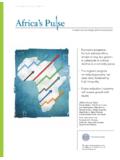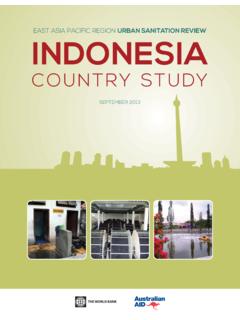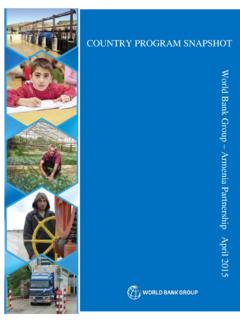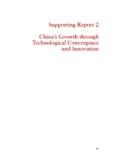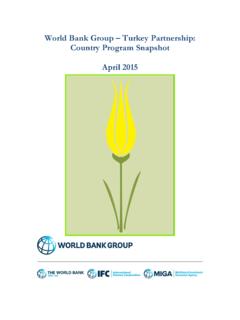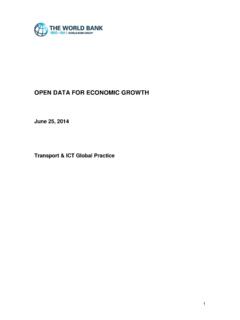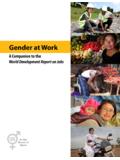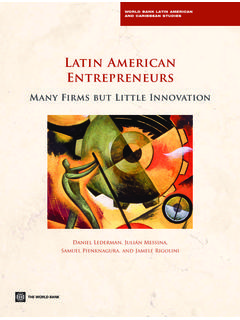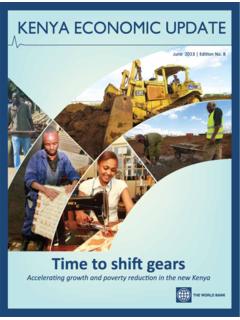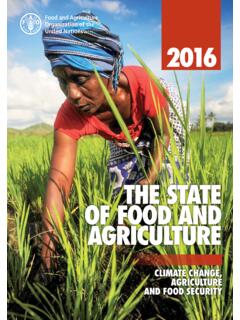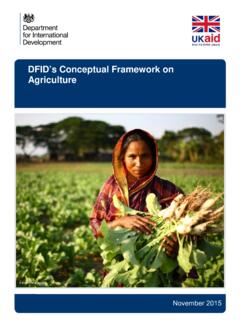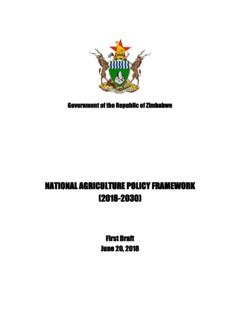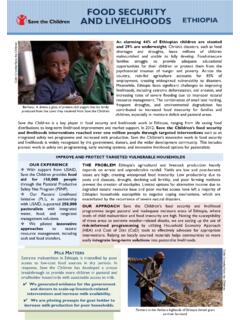Transcription of Climate-Smart Agriculture - World Bank
1 Climate-Smart AgricultureA Call to ActionB Climate-Smart Agriculture seeks to increase sustainable productivity, strengthen farmers resilience, reduce Agriculture s greenhouse gas emissions and increase carbon sequestration. It strengthens food security and delivers environmental benefits. Climate-Smart Agriculture includes proven practical techniques such as mulching, intercropping, conservation Agriculture , crop rotation, integrated crop-livestock management, agroforestry, improved grazing, and improved water management and innovative practices such as better weather forecasting, more resilient food crops and risk insurance. 1 ForewordFeeding people in decades to come will require ingenuity and innovation to produce more food on less land in more sustainable ways.
2 Climate change will exacerbate already tight resource constraints by making weather more extreme and variable and by decreasing average yields worldwide. Population growth, changing diets and land and water scarcity are also long-term trends that threaten our shared vision of a more prosperous future in which well-fed people everywhere are able to achieve their full potential without damaging their environment. Already, these pressures are forcing farmers and researchers to reassess mainstream farming techniques and consider alternative approaches to securing food , including conservation Agriculture , integrated crop-livestock management, intercropping and good news is that there is no shortage of women and men ready to take the last century s agricultural advances into a new era of opportunity.
3 Collectively, we can tap into well-proven production practices, information technology and scientific findings, to rapidly scale up policies and practices that achieve the triple win of food security , adaptation and mitigation. That goal is within reach if we build on our successes and create the right incentives for site-specific sustainable land management practices around the World . To feed the continent s 900 million people, Africa needs its own food security . This can only be achieved through a uniquely African Green Revolution. It must be a revolution that recognizes that smallholder farmers are the key to increasing production, promotes change across the entire agricultural system, and puts fairness and the environment at its heart Kofi A. Annan, Chair of the Board of the Alliance for a Green Revolution in Africa (AGRA, 2010)Left: A girl stands among the sorghum crops protected by trees in Niger.
4 Photo: Petterik The Global ChallengeClose to 1 billion people went hungry in 2010 according to the food and Agriculture Organization (FAO) of the United Nations. In 2011, hunger plagued the Horn of Africa, hit by the worst drought in 60 years. The future is daunting too: food needs are projected to increase by 70 percent by 2050 when the global population reaches 9 billion, while climate change is projected to reduce global average yields. Climate change will affect Agriculture through higher temperatures, greater crop water demand, more variable rainfall and extreme climate events such as heat waves, floods and droughts. Marginal areas, where low yields and poverty go hand in hand, may become even less-suited for Agriculture as a result of land degradation through deforestation, wind and water erosion, repetitive tillage and overgrazing.
5 Many impact studies point to severe crop yield reductions in the next decades without strong adaptation measures particularly in Sub-Saharan Africa and South Asia, where rural households are highly dependent on Agriculture and farming systems are highly sensitive to temperature increases and volatile climate. One assessment, based on a pessimistic assumption about global warming, estimates that by the 2080s World agricultural productivity will decline by 3-16 percent. The loss in Africa could be 17-28 percent (Cline 2007).While Agriculture is the sector most vulnerable to climate change, it is also a major cause, directly accounting for about 14 percent of greenhouse gas emissions, or approximately 30 percent when considering land-use change, including deforestation driven by agricultural expansion for food , fiber and fuel (IPCC 2007).
6 And yet, Agriculture can be a part of the solution: helping people to feed themselves and adapt to changing conditions while mitigating climate change. The ChAllenge in AfriCA Climate projections for Africa (IPCC 2007) include a likely average temperature increase of to 4 C in this century, higher than the global average. Assuming even moderate temperature rises, warming and drying could reduce crop yields by 10 20 percent by 2050 in Africa (Jones and Thornton, 2009). This overall projection translates into much more severe losses in certain places and does not account for extreme events: pests and diseases; droughts, heat stress and floods. In Sub-Saharan Africa, 250 million people went hungry in 2010 almost a third of the population. Hunger is particularly prevalent in arid and semi-arid lands, where soil quality has been decreasing for several decades.
7 Chronically poor crop performance 3and a high risk of crop failure in these systems, combined with low levels of rural development, have acted to dissuade farmers from investing in soil fertility improvements. From 1945 to 1990, soil nutrient removals (without replenishment with fertilizers or manure) and other forms of soil degradation reduced agricultural productivity in Africa by an estimated 25 percent (UNEP 1990). Increasing organic matter in soils in cropping systems will be critical to retain water, increase yields and reduce risks in rainfed Agriculture while sequestering carbon. The Global Partnership on Forest Landscape Restoration estimates that over 400 million hectares of degraded forest landscapes in Africa offer opportunities for restoring or enhancing the functionality of mosaic landscapes that mix forest, Agriculture and other land uses.
8 A range of well-established restoration options can improve human livelihoods, repair ecosystems and increase the resilience of both people and landscapes to climate Forestry / Land-Use Change14% Agriculture3% Waste and Wastewater 19% Industry8% Residential and Commercial Buildings 13% Transport 26% Energy Supply 7% Manure Management 11% Rice Production 12% Biomass Burning32% CH4 from Enteric Fermentation 38% N20 from Soil Management Greenhouse Gas Emissions by SectorEmissions in the Agriculture SectorSource: IPCC 2007; Smith et al. How Climate-Smart Agriculture Can HelpIn countries where the economy is heavily based on Agriculture , development of the agricultural sector is the most efficient poverty reduction measure. Yet agricultural expansion for food production and economic development which comes at the expense of soil, water, biodiversity or forests, conflicts with other global and national goals.
9 For example, forest loss undermines efforts to reduce emissions from deforestation and forest degradation and has negative repercussions on livelihoods and sustainable Agriculture because of the many ways in which trees produce goods (fruits, energy, fodder, timber), mitigate poverty in times of stress, and provide vital ecosystem services (whether by regulating water, housing pollinating bats and bees, or maintaining soil fertility and erosion control). The loss of tree cover also increases people s exposure to violent weather, depletes biodiversity and alters micro avoid solving a problem while exacerbating another, policy leaders should take an integrated approach to food security , poverty and climate approaches include: Integrated planning of land, Agriculture , forests, fisheries and water at local, watershed and regional scales, to ensure synergies are properly captured.
10 Promoting activities that increase carbon storage, combine animal husbandry and trees with food production, and are geared towards improving soil fertility. Reducing a variety of emissions from Agriculture such as nitrous oxygen from fertilizer application, livestock emissions and methane from rice cultivation. Exploring carbon finance as a lever to promote sustainable agricultural practices that have many other direct benefits for smallholder farmers and the environment. 5 Diversifying income sources and genetic traits of crops to help farmers hedge against an uncertain climate. Developing sound risk insurance and risk management strategies as well as resilience building strategies including safety nets that reach the poorest farmers. Adaptive management that disseminates timely climate information to farmers and monitors the local outcomes of different actions, builds on the traditional knowledge of farmers, and tailors techniques to shifting climatic conditions without harming intensification seeks to increase yield per unit of land to meet today s needs without exceeding current resources or reducing the resources needed for the future.

